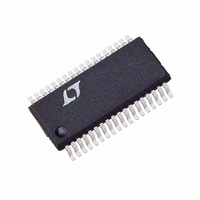LTC1759CG#TRPBF Linear Technology, LTC1759CG#TRPBF Datasheet - Page 24

LTC1759CG#TRPBF
Manufacturer Part Number
LTC1759CG#TRPBF
Description
IC SMART BATTERY CHARGER 36SSOP
Manufacturer
Linear Technology
Datasheet
1.LTC1759CGPBF.pdf
(28 pages)
Specifications of LTC1759CG#TRPBF
Function
Charge Management
Battery Type
Smart Batteries
Voltage - Supply
11 V ~ 24 V
Operating Temperature
0°C ~ 70°C
Mounting Type
Surface Mount
Package / Case
36-SSOP (0.200", 5.30mm Width)
Lead Free Status / RoHS Status
Lead free / RoHS Compliant
Available stocks
Company
Part Number
Manufacturer
Quantity
Price
APPLICATIONS
LTC1759
Step 1: Determine R
your maximum charge current, calculate the sense resis-
tor value and round to the nearest standard value. Any
rounding error is made up by the R
The value of the V
trade-off between minimize power dissipation in the cur-
rent sense resistor and maintaining good current scale
accuracy is to use V
Step 2: Determine the value of R
Round R
Step 3: Determine the value of R
lookup function based on your I
cal Characteristics table for allowable R
to Table 8 per recommended resistor values.
Inductor Selection
Higher operating frequencies allow the use of smaller
inductor and capacitor values. A higher frequency gener-
ally results in lower efficiency because of MOSFET gate
charge losses. In addition, the effect of inductor value on
ripple current and low current operation must also be
considered. The inductor ripple current I
with higher frequency and increases with higher V
Accepting larger values of I
inductances, but results in higher output voltage ripple
and greater core losses. A reasonable starting point for
setting ripple current is I
maximum I
inductor value also has an effect on low current operation.
The transition to low current operation begins when the
inductor current reaches zero while the bottom MOSFET is
on. Lower inductor values (higher I
occur at higher load currents, which can cause a dip in
24
R
R
Use R
R
R
Use R
SENSE
SENSE
SET
SET
I
L
= V
= 2.465/(1.25 • 4.092) • 200/0.025 = 3.855k
SENSE
SET
SET
= 0.1V/4.092A = 0.024
= V
f L
REF
1
= 3.83k
to the nearest standard value.
L
SENSE
occurs at the maximum input voltage. The
/(1.25 • I
= 0.025
V
OUT
SENSE
U
/I
SENSE
MAX
SENSE
1
MAX
voltage is user-definable. A good
INFORMATION
U
V
= 100mV for full-scale current.
. Using your chosen I
V
L
OUT
) • R
IN
= 0.4(I
MAX
L
S1
allows the use of low
SET
ILIMIT
/R
W
SET
value. See the Electri-
MAX
SENSE
resistor calculation.
L
ILIMIT
) will cause this to
. V
. This is simply a
). Remember the
REF
values. Refer
L
is 2.465V.
decreases
U
MAX
IN
.
for
efficiency in the upper range of low current operation. In
practice 15 H is the lowest value recommended for use.
Calculating IC Power Dissipation
The power dissipation of the LTC1759 is dependent upon
the gate charge of Q2 and Q3. The gate charge is deter-
mined from the manufacturer’s data sheet and is depen-
dent upon both the gate voltage swing and the drain
voltage swing of the FET.
Example: V
Q
Soft Start and Undervoltage Lockout
The LTC1759 is soft started by the 0.33 F capacitor on the
V
then ramp up at a rate set by the internal 45 A pull-up
current and the external capacitor. Battery charging cur-
rent starts ramping up when V
full current is achieved with V
capacitor, time to reach full charge current is about 10ms
and it is assumed that input voltage to the charger will
reach full value in less than 10ms. The capacitor can be
increased up to 1 F if longer input start-up times are
needed.
In any switching regulator, conventional timer-based soft
starting can be defeated if the input voltage rises much
slower than the time out period. This happens because the
switching regulators in the battery charger and the com-
puter power supply are typically supplying a fixed amount
of power to the load. If input voltage comes up slowly
compared to the soft start time, the regulators will try to
deliver full power to the load when the input voltage is still
well below its final value. If the adapter is current limited,
it cannot deliver full power at reduced output voltages and
the possibility exists for a quasi “latch” state where the
adapter output stays in a current limited state at reduced
output voltage. For instance, if maximum charger plus
computer load power is 30W, a 15V adapter might be
current limited at 2.5A. If adapter voltage is less than
(30W/2.5A = 12V) when full power is drawn, the adapter
C
G2
P
P
= 441mW
pin. On start-up, V
D
D
= Q
= (V
= (18V – 9.1V)(230kHz • 40nC) + 18V • 20mA
G3
VCC
= 20nC, I
VCC
– V
= 18V, V
GBIAS
VCC
C
pin voltage will rise quickly to 0.5V,
)[f
= 20mA.
PWM
GBIAS
(Q
C
C
= 9.1V, f
voltage reaches 0.7V and
G2
at 1.1V. With a 0.33 F
+ Q
G3
)] + V
PWM
= 230kHz,
VCC
• I
VCC












